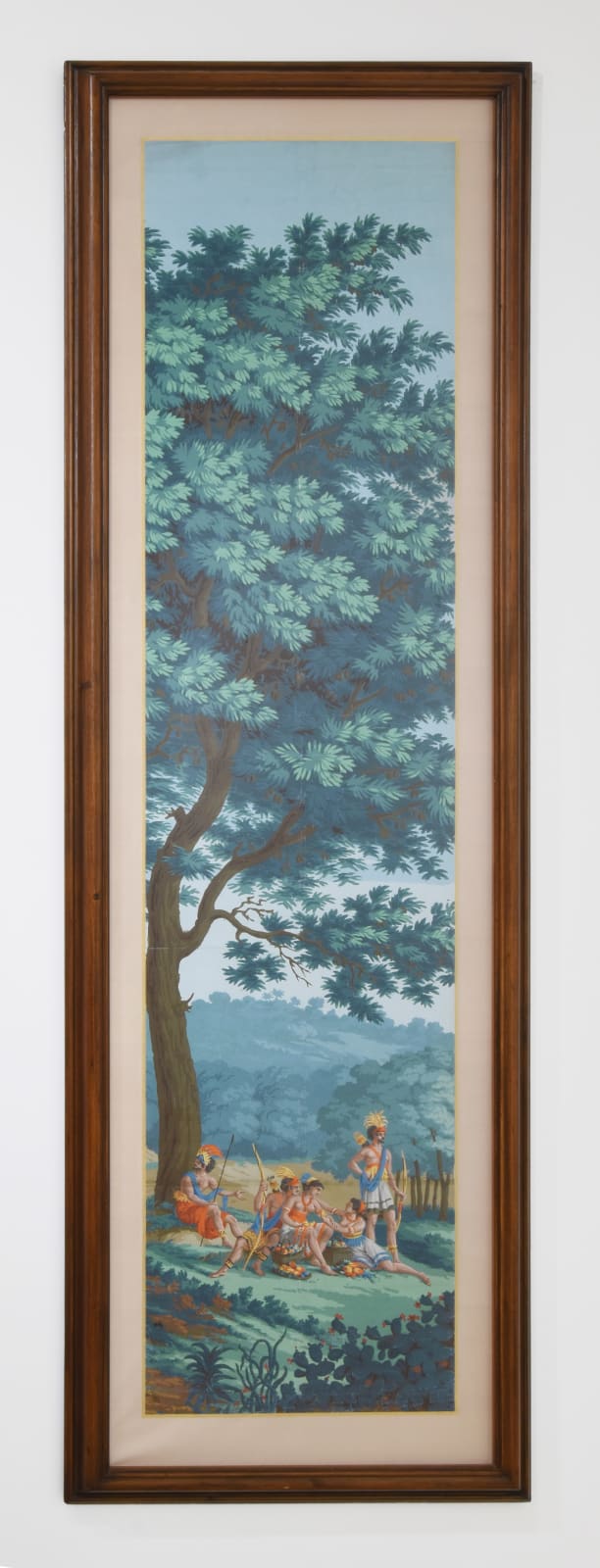




Joseph Dufour
Sauvages de la Mer Pacifique, panel 2, c.1805
hand coloured woodblock
2265 x 525mm
2600 x 800mm framed
2600 x 800mm framed
Further images
In 2017, Lisa Reihana wowed audiences at the Venice Biennale with her exhibition Emissaries. The central focus of the show was In Pursuit of Venus [infected], an immersive video installation...
In 2017, Lisa Reihana wowed audiences at the Venice Biennale with her exhibition Emissaries. The central focus of the show was In Pursuit of Venus [infected], an immersive video installation that examined European colonisation of the Pacific. Reihana’s work at the biennale was a showstopper, and it drew considerable acclaim. A key visual reference for this work was the 20-panel panoramic wallpaper, Les Sauvages de la Mer Pacifique produced by French wallpaper manufacturer Joseph Dufour et Cie in c1805.
Dafour’s remarkable wallpaper is historically significant. It was sold in Europe and North America at a time when interest in the South Pacific was burgeoning in the wake of Cook’s voyages. Its depictions of largely idyllic scenes from across the Pacific proved highly popular with wealthy individuals, who chose it to adorn their homes. It presents an arcadian vision in a Pacific setting, showing a Tahitian picnic with figures that appear influenced by neo-classical, idealised depictions of Roman centurions or Greek archers. The wallpaper was produced in the Lyonnais town of Macon by Dufour (1752-1827) after designs by the little-known Jean-Gabriel Charvet (1750-1829). Incorporating ideas from theatre and landscape design, it captures the intense French interest in the south seas of the 19th Century. Les Sauvages de la Mer Pacifique has also retained the interest of contemporary viewers, providing a rich visual reference for the colonial attitudes of the time.
This is one panel from the panorama, section 2 of 20, and it is in pristine condition. It was purchased as an unrolled specimen from Maggs, the famous rare books and manuscripts dealers in London in the late 1980s or early 1990s. It was formerly held in the private collection of Derek McDonnell, a rare books and manuscripts expert, since that time. It is in remarkable condition, having not been restored, and the colour remains rich and unspoilt. The National Gallery of Australia collection includes a full set that has been restored, and the San Francisco Museum and the Honolulu Museum of Art both have full sets. It is a rare and valued icon of the Pacific, and a fine example of early 19th century French colour printing.
Dafour’s remarkable wallpaper is historically significant. It was sold in Europe and North America at a time when interest in the South Pacific was burgeoning in the wake of Cook’s voyages. Its depictions of largely idyllic scenes from across the Pacific proved highly popular with wealthy individuals, who chose it to adorn their homes. It presents an arcadian vision in a Pacific setting, showing a Tahitian picnic with figures that appear influenced by neo-classical, idealised depictions of Roman centurions or Greek archers. The wallpaper was produced in the Lyonnais town of Macon by Dufour (1752-1827) after designs by the little-known Jean-Gabriel Charvet (1750-1829). Incorporating ideas from theatre and landscape design, it captures the intense French interest in the south seas of the 19th Century. Les Sauvages de la Mer Pacifique has also retained the interest of contemporary viewers, providing a rich visual reference for the colonial attitudes of the time.
This is one panel from the panorama, section 2 of 20, and it is in pristine condition. It was purchased as an unrolled specimen from Maggs, the famous rare books and manuscripts dealers in London in the late 1980s or early 1990s. It was formerly held in the private collection of Derek McDonnell, a rare books and manuscripts expert, since that time. It is in remarkable condition, having not been restored, and the colour remains rich and unspoilt. The National Gallery of Australia collection includes a full set that has been restored, and the San Francisco Museum and the Honolulu Museum of Art both have full sets. It is a rare and valued icon of the Pacific, and a fine example of early 19th century French colour printing.
Provenance
Private collection, Derek McDonnellPrivate collection, Auckland



